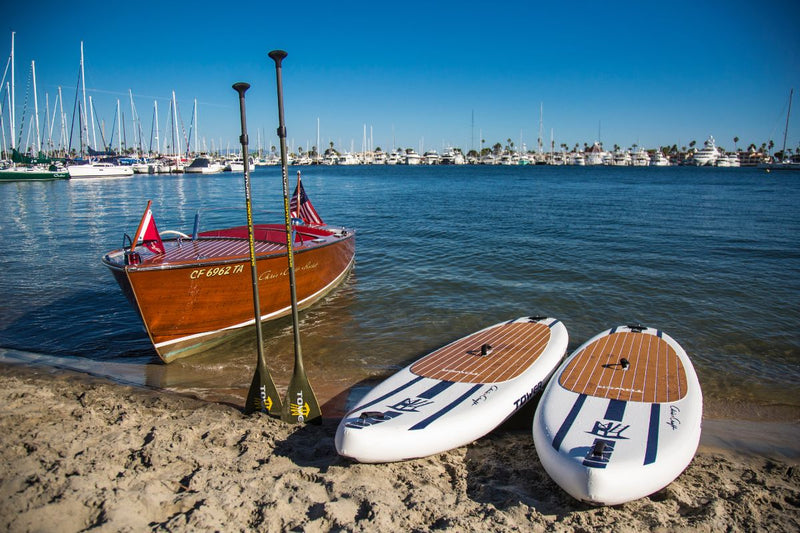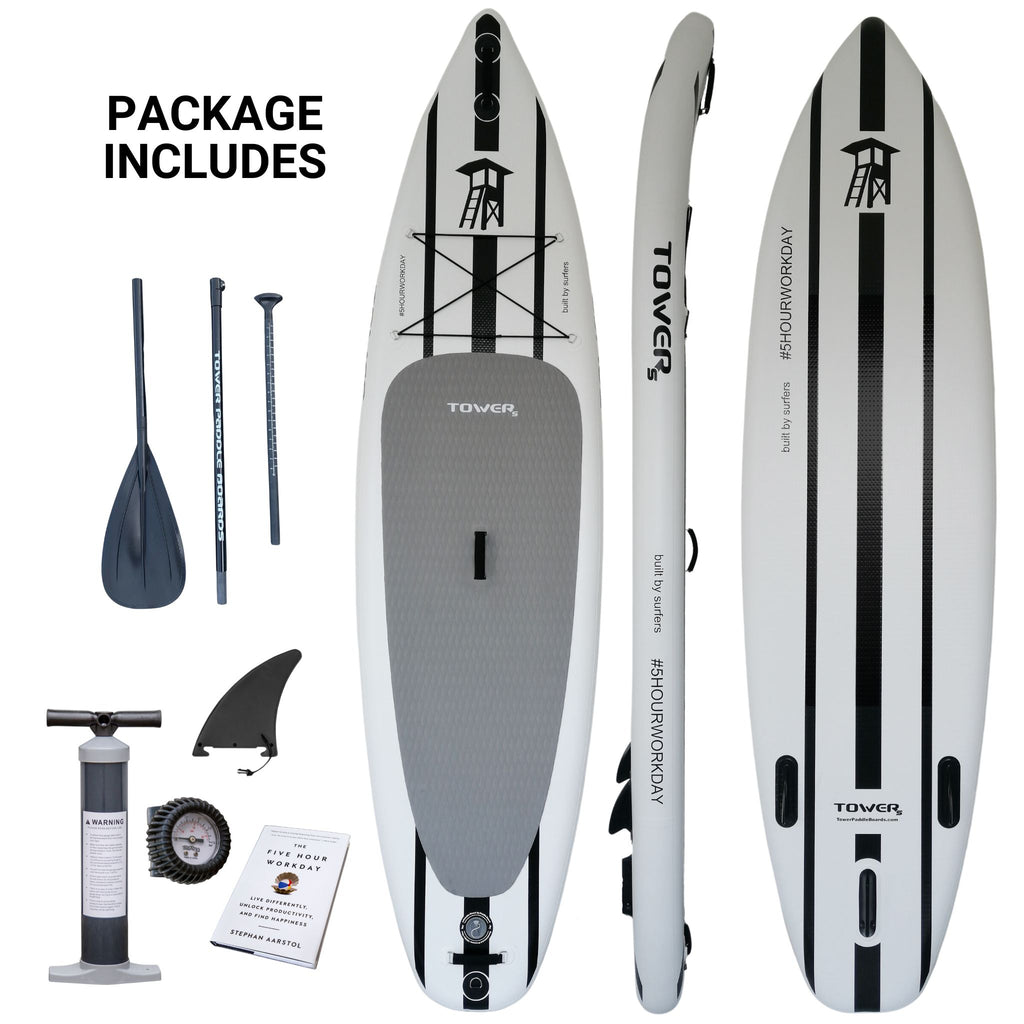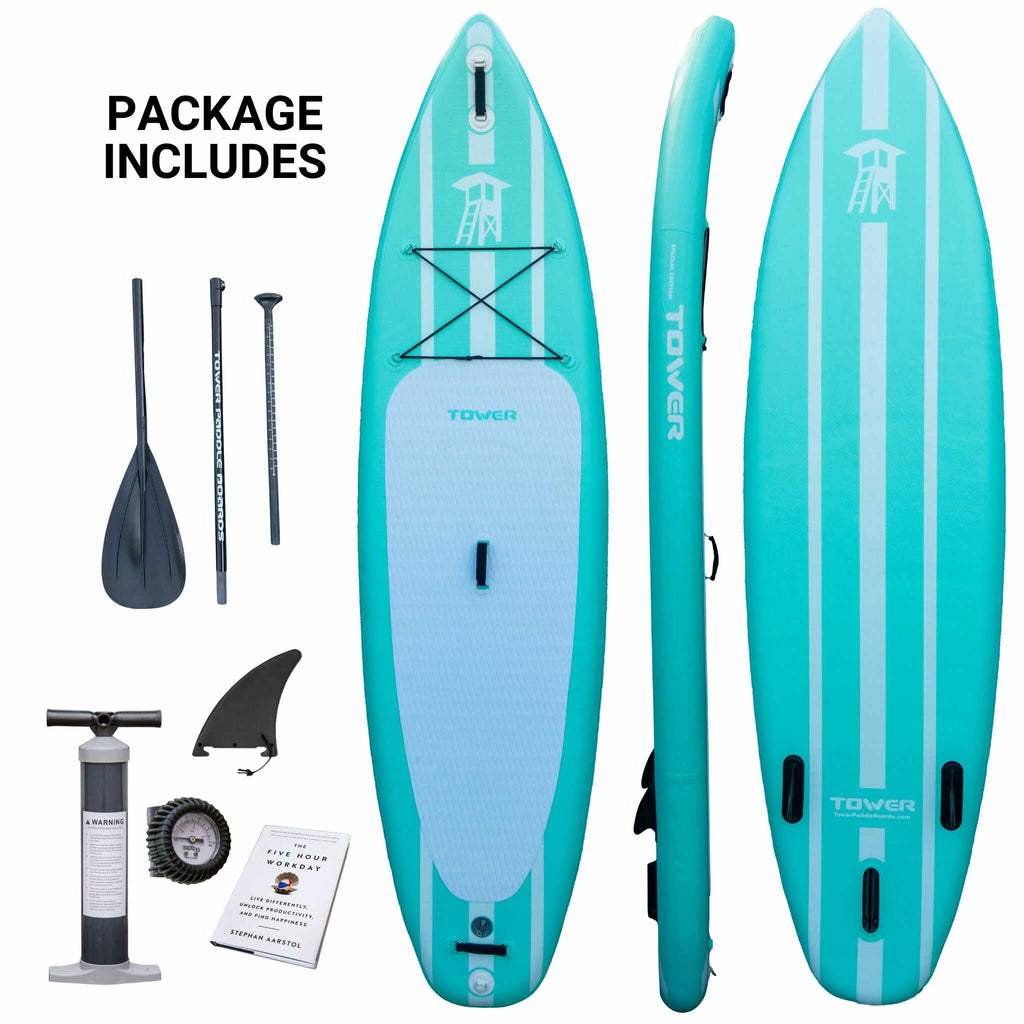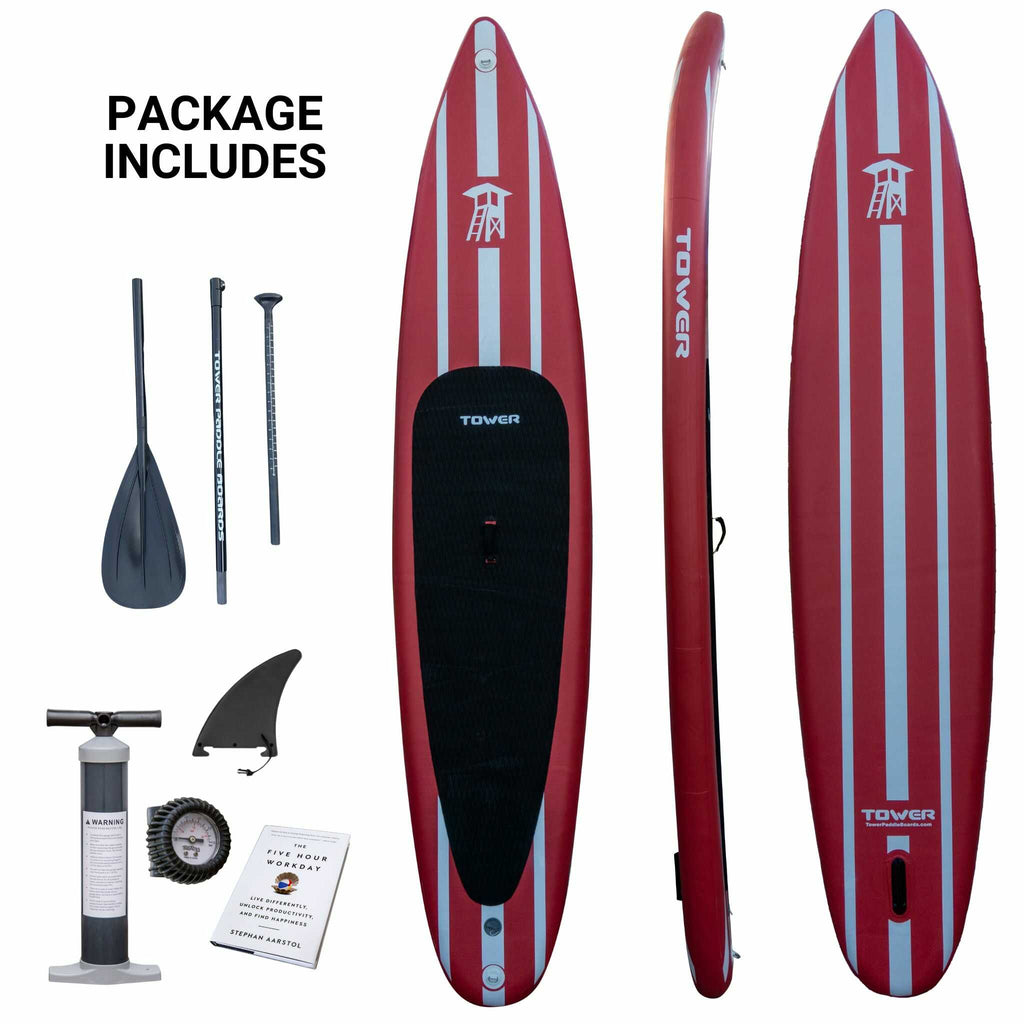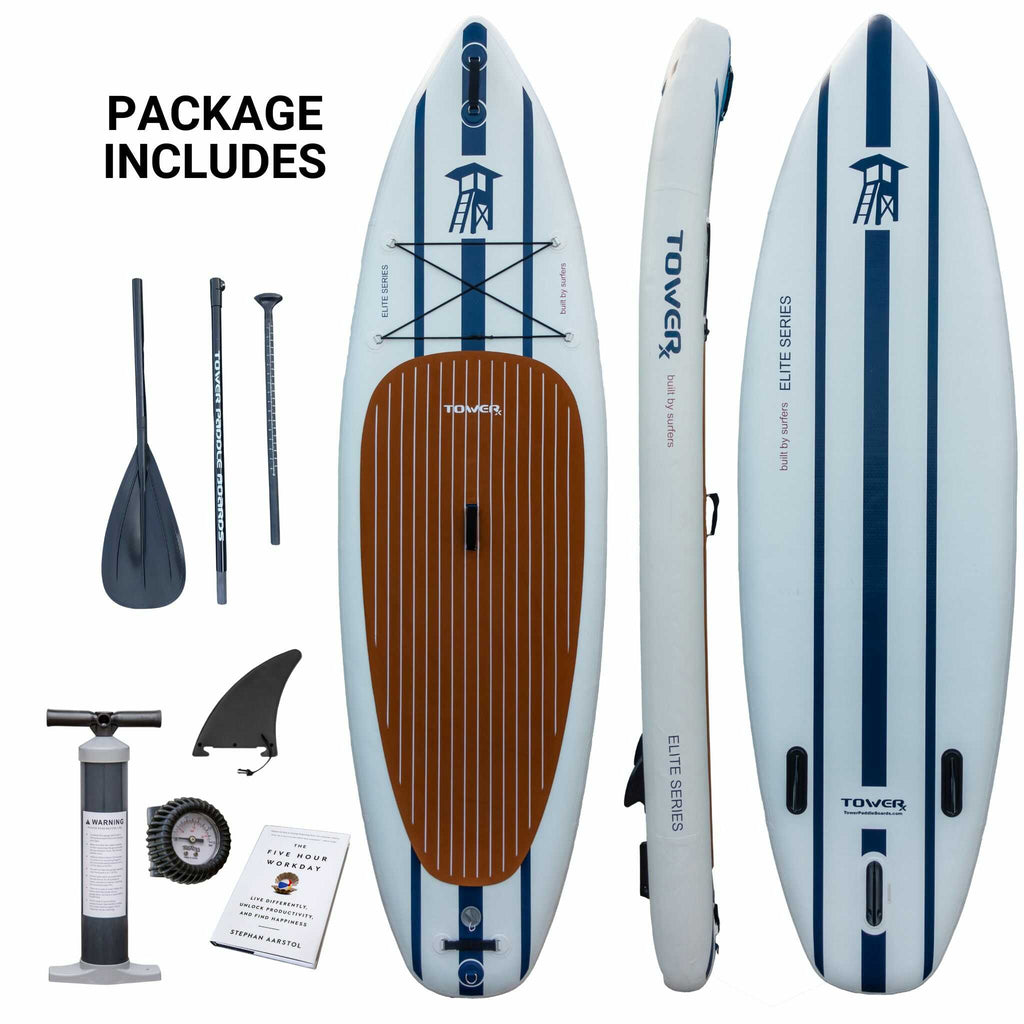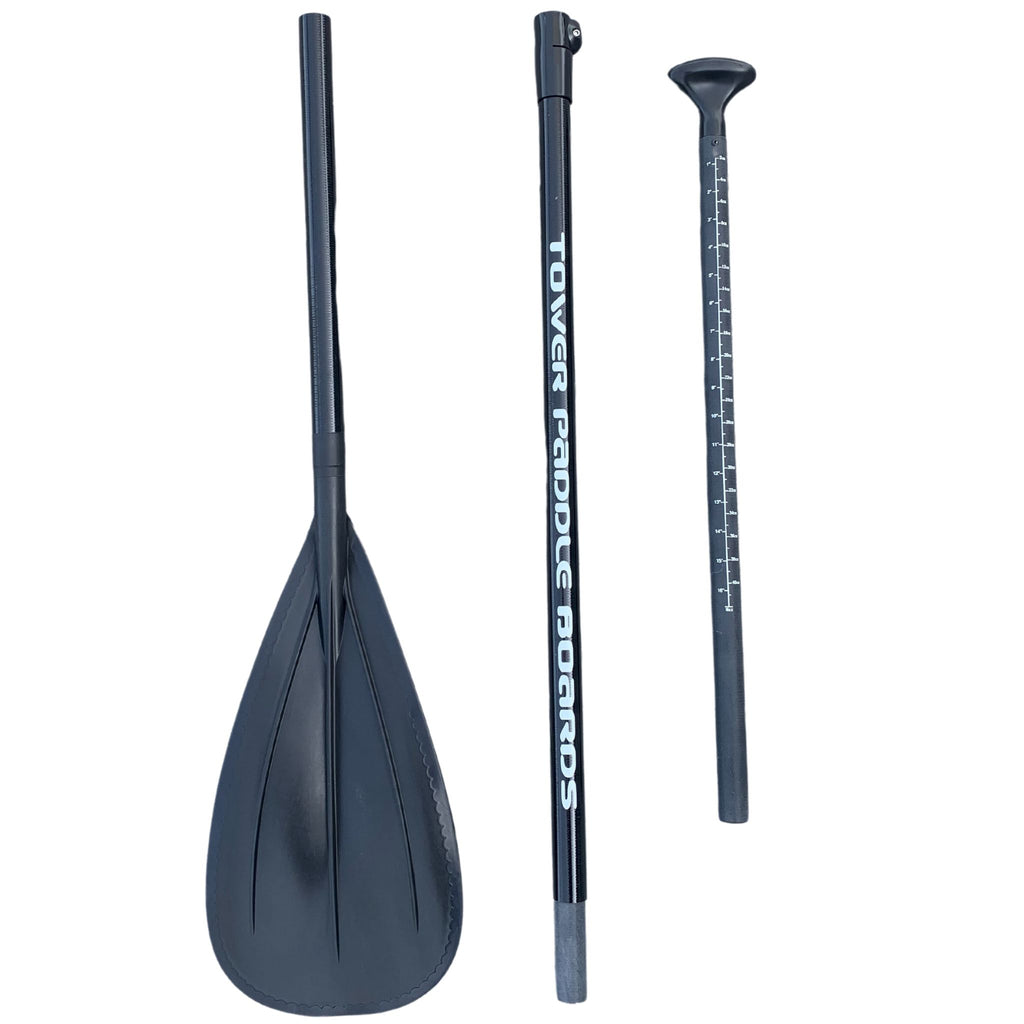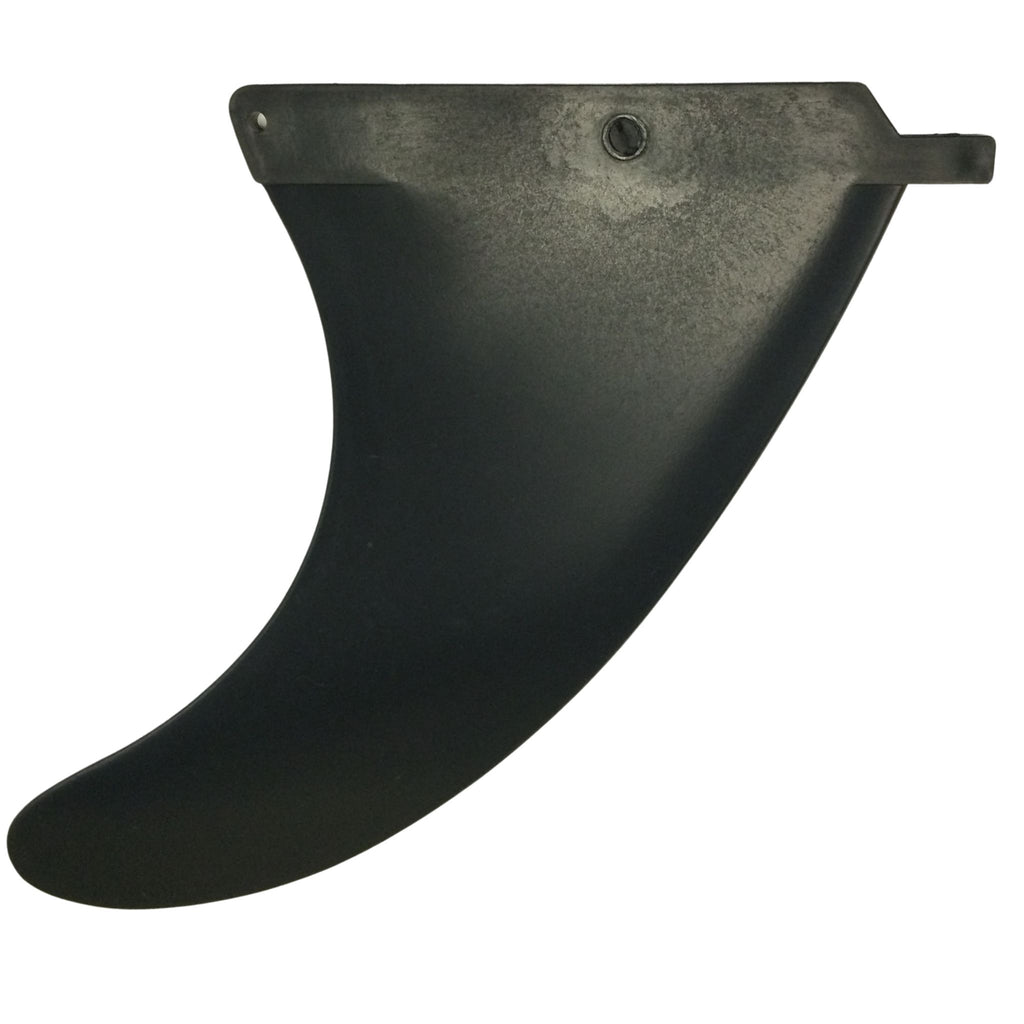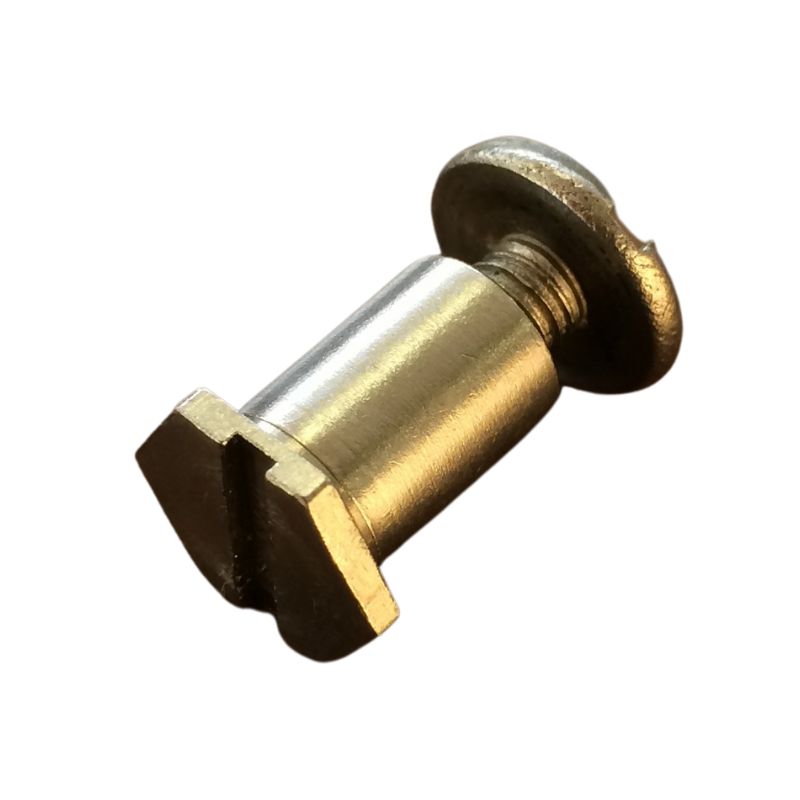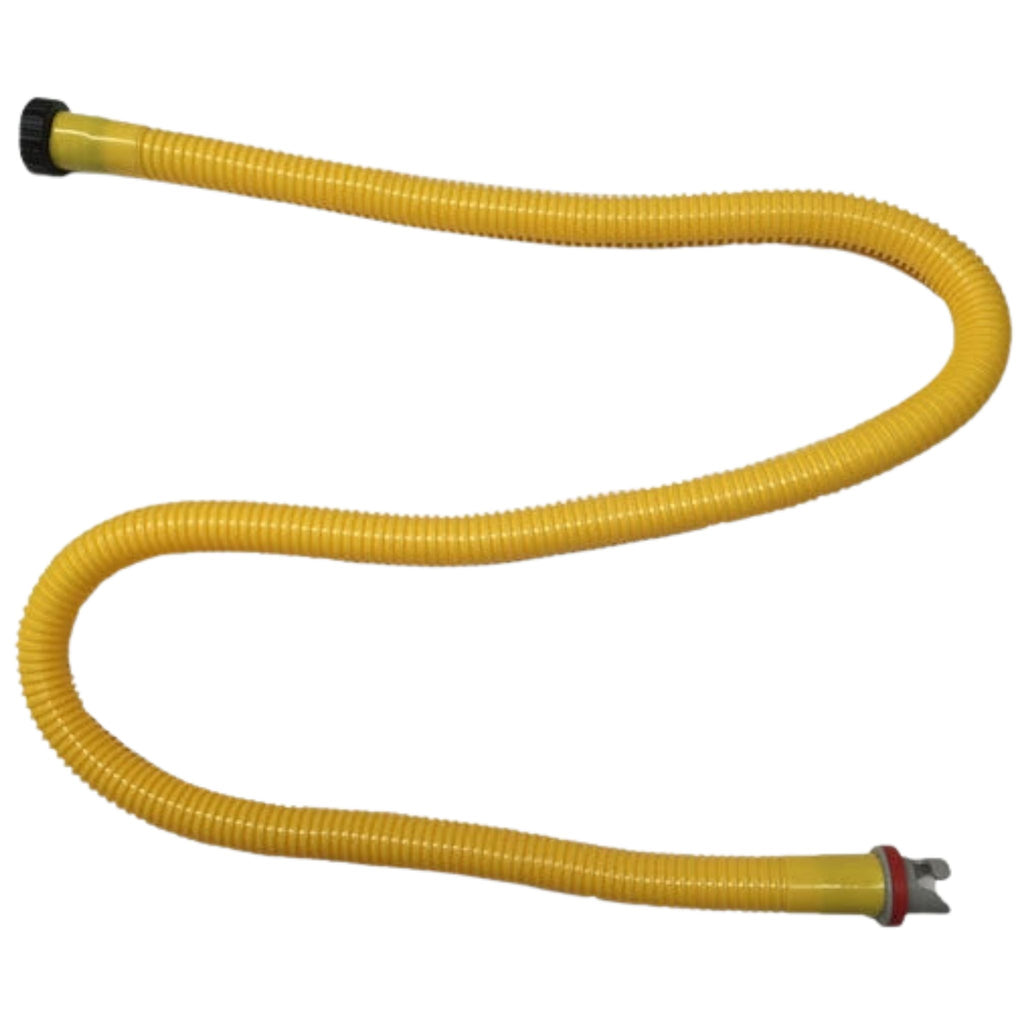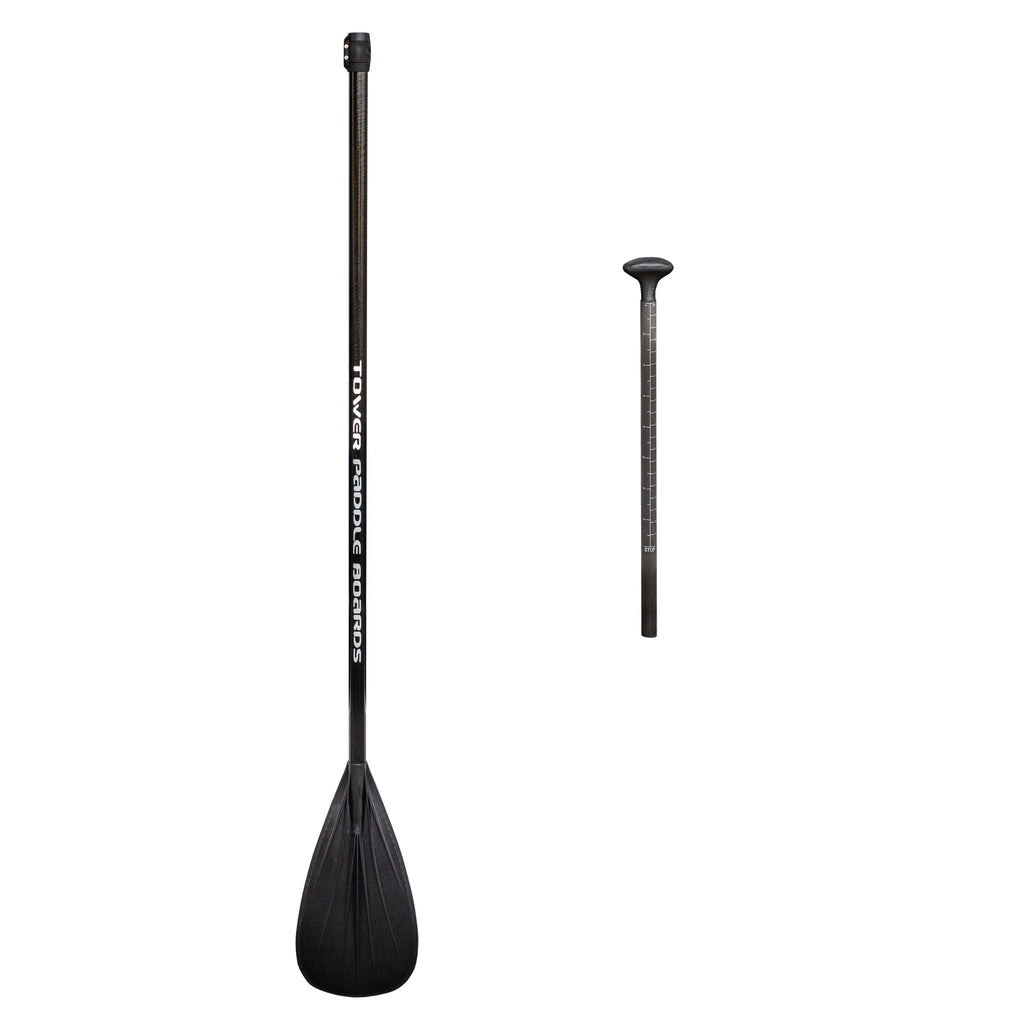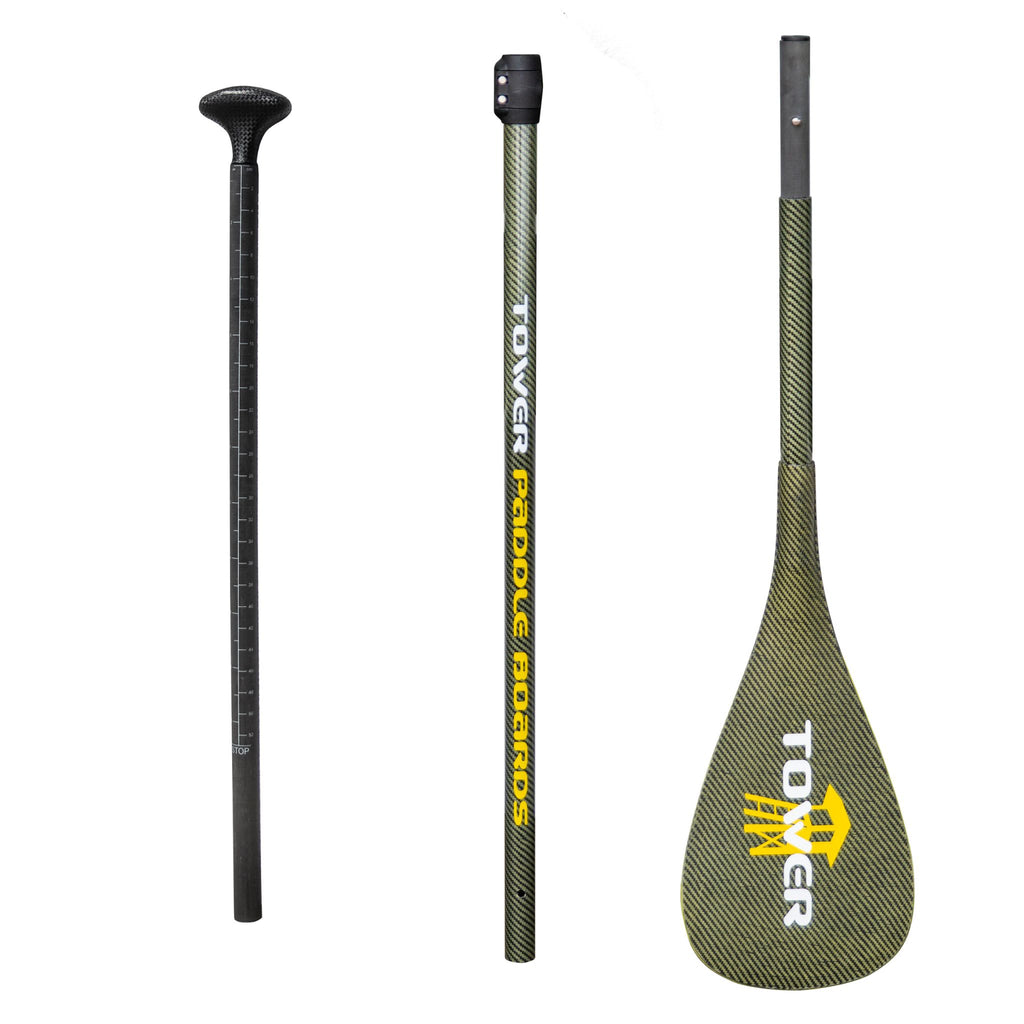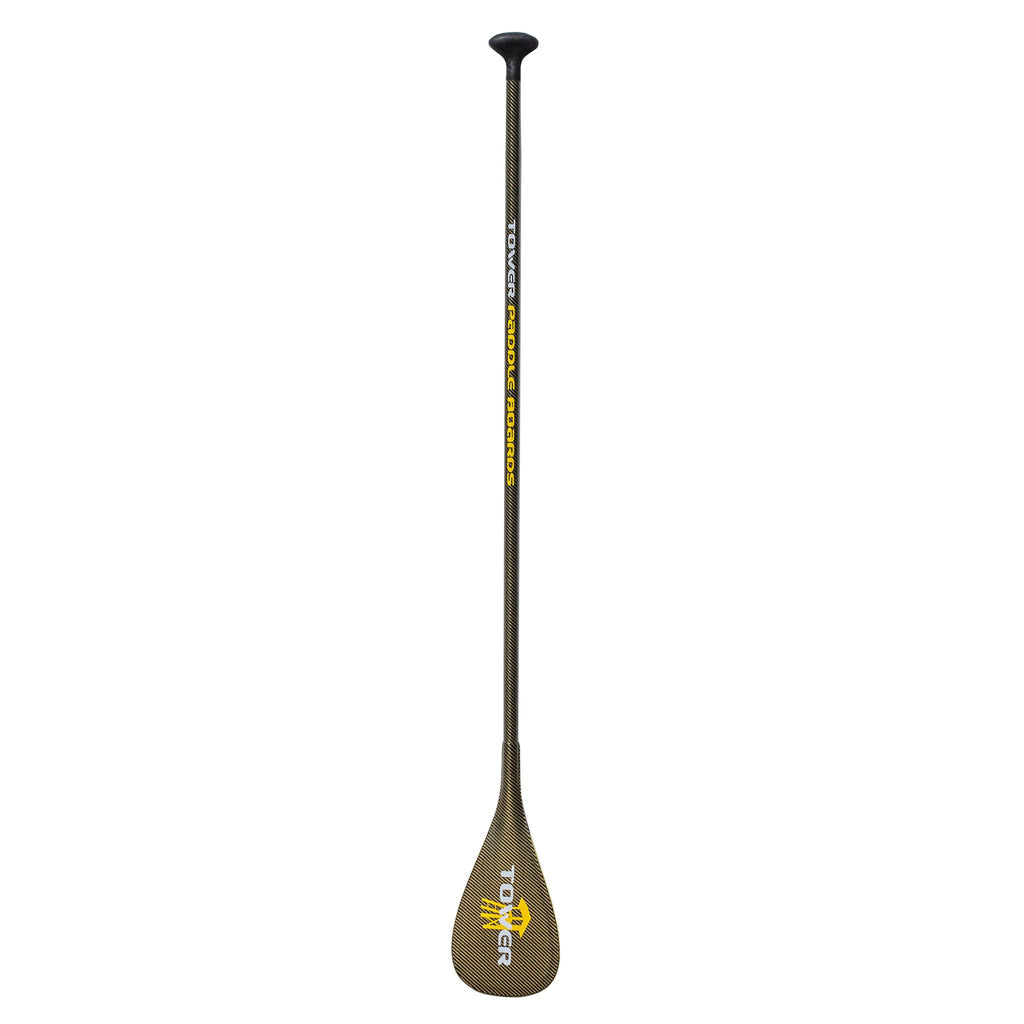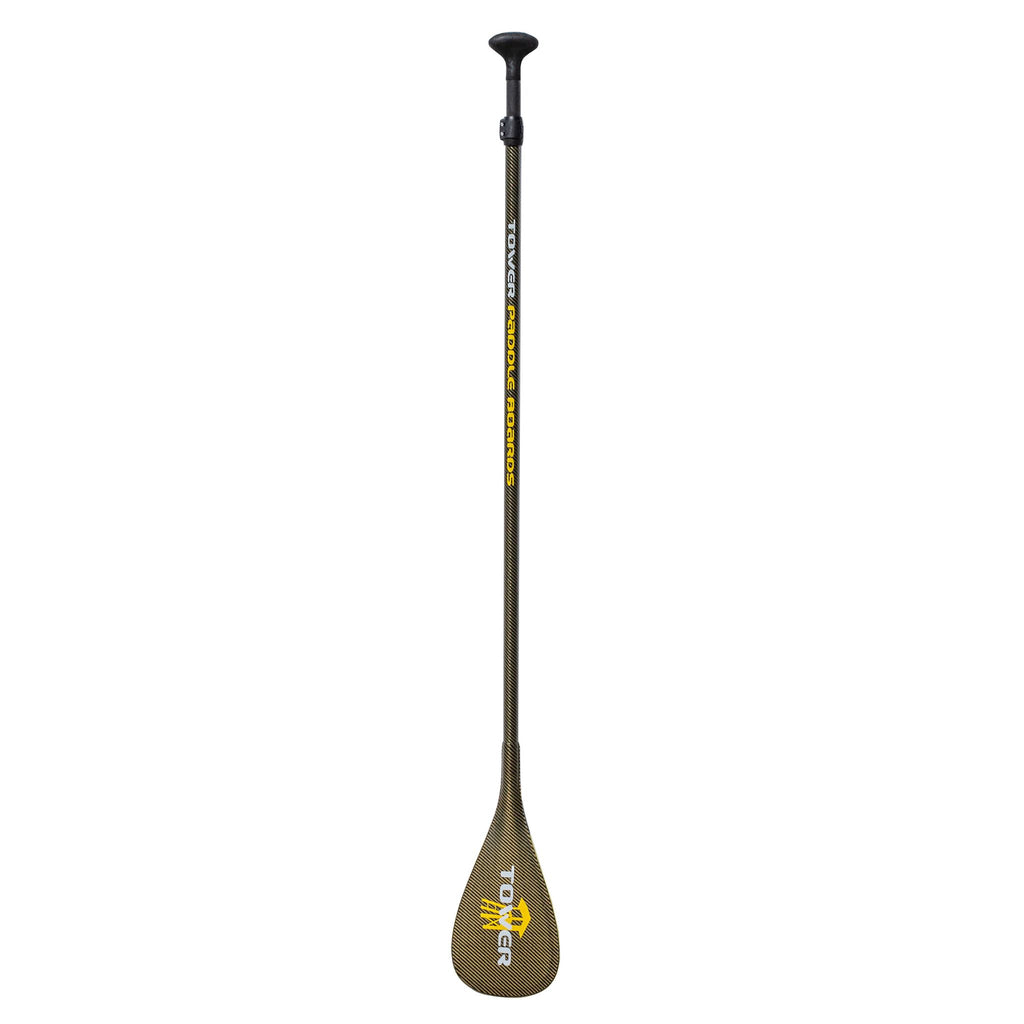iSUP Construction Explained & FAQ
There are only 3 base construction methods that produce all inflatable paddle boards worldwide. There can be "enhancements" added to each base construction method, but that doesn't fundamentally change the construction method used, and often times it's just marketing spin that really doesn't enhance anything. There is a lot of confusion and misinformation put into the market by less than upfront brands on inflatable paddle board quality and construction, so we've put together this comprehensive page to answer pretty much any question you might have on iSUP construction. Click the links below to get answers to each question:
- How do I know which board by which brand is made of which construction?
- Why would brands lie to their customers?
- How does Tower know so much about paddle board construction and the market evolution?
- Does "You get what you pay for" ring true for consumers buying paddle boards?
- How can fusion boards sell for as much or more than more durable superior double layer construction boards?
- Why are 6" thick iSUPs more rigid than 4" thick iSUPs? How about 8" thick ones?
- What exactly is double layer construction?
- What exactly is fusion construction?
- What exactly is single layer construction?
- Are there added enhancements to the 3 primary construction methods?
- What does the term “Raw drop stitch sheets” mean?
- What does the term “Single Layer DWF” mean?
- What does the term “Scrim” mean?
- What does the term “PVC tarpaulin Sandwich” mean?
- How does adding "pin lines" enhance iSUP construction?
- How does adding a sandwiched rail layer enhance iSUP construction?
- How does adding deck stringers enhance iSUP construction?
- What constructions does Tower Paddle Board offer?
The 3 iSUP Construction Methods

All the above are 6" thick iSUPs. Below is 8" thick double layer construction like Tower's X-Class Elite Series iSUPs
Construction "Enhancements"
*NOTE: While we show potential "Enhancements" to a double layer construction below, they can be done to any of the 3 construction methods. Few "Enhancements" truly enhance performance at all and most are "at best" just cosmetic or "at worst" done intentionally to deceive consumers with marketing spin.

Q. How do I know which board of which brand is made of which construction?
A. Here are the details:
- It’s challenging as shady brands intentionally obscure construction quality
- The best shortcut is to weigh a board & understand weight variables
- Contact us at Tower and ask about any brand/model you have a question on
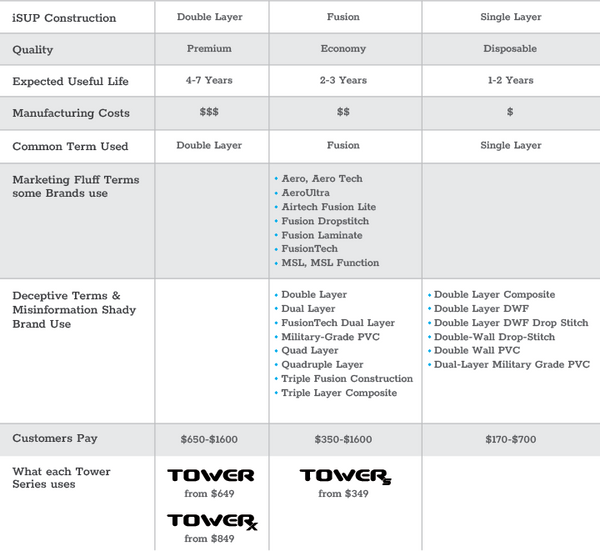
Why it’s challenging?
It’s extremely challenging because it’s commonplace in the SUP industry for brands to intentionally deceive their own customers. Oftentimes they just fabricate construction names entirely. They sell you a single layer construction board and shamelessly term its construction “dual-layer military-grade PVC”. They sell you a fusion construction board and call it “triple layer military grade PVC”, “Triple layer composite PVC”, or “Quadruple layer military grade PVC”. They quote drop stitch density. Brands that have only existed for a year or too offer you 3 or 5 year warranties (cross your fingers they exist by then, or answer the phone, or stand by their product). They conjure up techie sounding construction names like Airtech, Aerotech, Double Layer Light, etc. They try to spin fusion construction’s durability as somehow superior to double layer construction, or that the tradeoff is justified to save weight, when a few pounds is hardly even noticeable from the user prospective. Many just don’t even mention how their boards are constructed. And this above is the consumer perceived “major brands”, all before we even get into the Chinese non-brands selling on Amazon, which quickly devolves into just a general buyer beware situation.
Best “Tell” is the weight
Because from the iSUP exterior look it’s almost impossible to tell an inflatable board's construction, the only true way to tell is to cut them open honestly and see, but the best short cut is to weigh them because there is a fundamentally different amount of material used in each construction that’s hard to hide. Unfortunately, savvy brands even figured out a way to confuse this by adding 3-4 lbs of attachments and accessories which then can make a single layer board appear to be the weight of a fusion board, or make a fusion board appear to be the weight of a double layer board. We’re in the industry and we have a hard time telling, so you as a customer have no chance to know what you are buying. If you go the weight route, you have to discount weight for boards with excessive accessories, fin boxes, oversized traction pads, pinlines, added stringers, etc.
Make sure you factor in accessory weight as these can throw things off. Here are some example weights of various accessories:
- Plastic fin box – typically 0.4 lbs each
- Plastic GoPro mount – 0.2 lbs each
- Bungee cord – 0.25 lbs each
- Bungee handles – 0.07 lbs each
- D-rings – 0.02 lbs each
- Pinlines (aka “Seam Stripes”) – 0.75 lbs for a pair
- Oversized traction pad – up to another 0.5 lbs
- Glue – If you add 15 extra parts to an iSUP, the glue weight can quickly add up to 0.5 to 1.0 lbs.
So if you’re comparing an inflatable paddle board with a bunch of extra accessories (as compared to a more standard board with 3 handles, a regular size traction pad, 3-4 d-rings, lightweight fin boxes), the excessive accessories could easily add another 4-5 lbs of weight to a board. This can take a single layer’s board weight from 19 lbs to 24 lbs. Similarly, it can take a fusion construction board’s weight from 22 lbs to 27 lbs.
A less reliable way to ascertain an inflatable paddle board's actual construction is to look at the warranty, as they are all over the board, as is the reliability of those warranties and customer service in general. Many savvy brands have taken a marketing approach and offered longer warranties to convey quality and then just give as shoddy of service as they can and hope people don’t call them on it. You can find 5 year warranties for inflatable paddle boards on companies that haven’t even been in business for 5 years!
Contact Tower to find out
Another way you can determine is just to call or email us about a specific board model or brand and we might know already, as we occasionally get one and cut it open to see. If we don’t already have an answer for you, we’ll research one and get back to you. You can reach us at (858) 362-4082 or info@towerpaddleboards.com.
Q. Why would brands lie to their customers?
A. Newsflash, marketers lie and manipulate for a living. It can be a nasty business at times. The inflatable SUP industry has seen incredible growth over the past decade or so. This growth attracted a lot of fly-by-night SUP brands and factories into the mix. In jockeying for position, while simultaneously trying to meet massive production demand increases, factories have pushed brands onto easier and cheaper to produce and highly automated construction methods (as China always does), and in turn brands have pushed these onto customers. Today, the vast majority of boards sold are the lowest quality single layer, and the vast majority of brands only offer either single layer construction or fusion construction boards to their customers. Nonetheless, they keep trying to pass it all off as high quality double layer construction, or alternatively trying to flip the script and argue that fusion construction is better because it’s lighter.

Q. How does Tower know so much about paddle board construction and the market evolution?
A. Because we’ve been there from the beginning and we’ve watched it all unfold. Tower Paddle Boards introduced the first 6” thick double layer construction inflatable paddle board onto the market in early 2012. Footage from the July 2011 filming of Tower’s Shark Tank pitch shows Tower’s pioneering 6” thick iSUP that changed the industry.
In 2012, Tower was the first brand to sell 6” thick paddle boards on Amazon. A few years later, we’d be mentioned by name in Jeff Bezo’s annual letter to stockholders. One other traditional retail brand, Naish, launched a 6” thick iSUP in 2012 in addition to their 4” model, which they continued to offer because (as they termed it at the time) it was “lighter weight and thus more portable”. A handful of brands had 4” models for years and the inflatable share of the paddle board market was less than 1%. After a few years of brands continuing to carry their 4” thick junk boards because they were “lighter”, they abandoned the ruse and 4” paddle boards are pretty much extinct today because they are in fact useless. Originating with Tower Paddle Board's introduction of 6” iSUPs in 2011, today inflatable SUPs are north of 90% of the SUP market. Entire brands popped up just to sell inflatable SUPs. Pretty much every 6” thick inflatable paddle board and paddle board brand followed in Tower Paddle Board's pioneering footsteps and many even followed us onto selling on Amazon.
Q. Does "You get what you pay for" ring true for consumers buying paddle boards?
A. Quality of product and production costs have almost nothing to do with what consumers pay for paddle boards. Brands frequently price high intentionally because they know price is the #1 indicator of quality in consumer's minds. It's a short cut that's rang true throughout history for the most part, but now with some things sold thru the retail distribution, some sold thru heavy ad-supported direct to consumer sales, and some sold truly direct to consumer with no middlemen (ads, retailers, Amazon, etc.), the term "You Get What You Pay For" is no longer reliable. More accurate is you pay for what distribution channel you buy thru. Some brands price high to cover all the middleman costs. Some brands price low and pretend to be selling you something better than you are getting. It's all over the board. Other brands, like Tower, sell the best quality on the market but still price very fairly because we sell truly direct to consumer ONLY and stubbornly spend as little on advertising as we can (so we can pass those savings onto you).
Double layer, hand glued construction iSUPs sell for between $550 and $1600. Fusion construction iSUPs sell for between $350 and $1600. Single layer construction iSUPs sell for $170 to $700. What you pay depends largely on the brand you buy from and the distribution strategy they use to offer the product to you. Tower Paddle Boards, as one of the only direct to consumer ONLY brands in paddle boards, offers unrivaled value at every construction quality we compete in.
To understand the channel you are buying thru, look at the brand. Are you buying thru Amazon? They take 15% revenue share plus another 30%+ in ad costs regularly for brands that appear near the top of the search results, so it's basically retail. Are you buying thru a retail shop. They take 30% to 50% retail margins. Even if you are buying from a website, search their website for "wholesale inquiries" or "dealer inquiry" for signs that they sell thru the retail distribution too, which means they bundle those margins into your "direct" prices. And if you Google something like "paddle boards" and see their ads pop up, and then their banner ads follow you around everywhere for the next few months, likely they are paying 30%+ of your purchase prices to Google Ads or Facebook.
Q. How can fusion boards sell for as much or more than more durable superior double layer construction boards?
A. In a nutshell, it’s because of marketing manipulation. The prices consumers pay for inflatable SUPs have very little to do with what they cost to make. Well known brands regularly spend more on advertising to sell each board then they spend on the production cost of that board. When brands also sell thru retail stores or even Amazon, almost 50% of what you pay gets absorbed by the retailer or Amazon in the form of a revenue share and advertising costs. So the production cost is largely irrelevant to what the brand decides to charge you, the consumer.
Tower is one of the very few remaining direct to consumer ONLY brands out there (check other brand’s websites for a “wholesale inquiries” or “dealer inquiries” link). We're also one of the only brands that spends as little on advertising as we can get away with, so we're kind of an anomaly. Our ad spend the first 12 years of our existence was less than 3% of revenues - we only exceeded 3% one year in over a decade. We can do this because we're a well known brand, and we have a lot of great content like this on our site that attracts a lot of SUP enthusiasts organically. What we save in advertising costs, we pass on directly to consumers. Our prices are sometimes so low that people confuse us with brands selling low quality construction boards, when we are actually one of the only brands that primarily sells double layer construction. In fact, that’s all we sold for over a decade until Summer of 2022, when industry forces and other marketer’s rampant consumer manipulation compelled us to also offer a more economical fusion construction board (our S-Class Starter Series) and price it with our aggressive direct to consumer ONLY approach to compete head to head with brands selling cheap single layer boards. While we do sell on Amazon, we price there at ~20% above our website pricing to accommodate Amazon’s revenue share. We don’t build it into our direct to consumer prices.
Traditional retail brands (sold in physical retail stores) set the higher end of the pricing ranges for boards of all production methods, and with intense competition for a few retail brand slots they diligently try to differentiate with technological jargon. This is how fusion production came into existence. Even some of the most expensive brands use it exclusively, as it was a differentiator when it rolled out in 2016. Some copycats latched onto this “fusion is better” approach and went with it because it sounds good and it’s cheaper to manufacturer, while others just did it to save costs and then took the strategic approach of obscuring the fact that they weren’t offering hand glued, double layer boards. They made up names like triple layer boards, quad layer, whatever they could think it. Suddenly, everything was obscured and marketing slogans overwhelmed consumers ability to even understand what was what. Some of the shadier brands blatantly pass off single layer construction boards as dual-layer, and they just start counting whatever they want as a “layer” to the point that the 3 fundamental construction methods are almost completely obscured to customers.
Q. Why are 6" thick iSUPs more rigid than 4" iSUPs? How about 8" thick inflatables?
A. All else being equal, a 6" thick inflatable paddle board is 325% more rigid than a 4" thick iSUP. An 8" thick iSUP is 800% more rigid than a 4" thick iSUP and 240% more rigid than a 6" iSUP. In simple terms, there is an exponential relationship between the thickness of an inflatable paddle board and it's rigidity. If it's twice as thick, it's 2 cubed as rigid, so 8 times as rigid (2 x 2 x 2 = 8). The term rigidity here refers to a boards resistance to bending. This exponential relationship is the same principle that's used when determining beam thickness in building and civil engineering. It's all centered around something called the "Moment of Inertia". The formula is as follows:
MI = W x (DxDxD)/12
The Moment of Inertia ("MI") is equal to the width times the depth cubed, divided by 12.
This simple principle is what lead Tower Paddle Boards to pioneer 6" thick paddles boards in 2011. While other brands were settling for 4" thick boards and trying to make them more rigid by increasing the inflation PSI or adding "stringers" or other nonsense that really didn't do much of anything, we just made boards 50% thicker. The result was an inflatable paddle board that was 325% more rigid than the 4" predecessors. The entire SUP industry changed and iSUPs went from less than 1% of the market to over 90% today. A few years later, Tower also made an 8" thick iSUP, which is 800% more rigid than the old 4" iSUPs with our 14' long Xplorer. This is why our X-Class Elite Series are some of the most rigid iSUPs on the market. Pretty much the entire industry copied our move to a 6" thick iSUP, but few if any brands followed us with our 8" thick iSUP. Over the past 7-8 years, our Xplorer has garnered a sort of cult following with bigger riders or those with the need for speed, as this rigidity makes this our fastest board. It's even faster than our hard boards!
With the introduction of our X-Class Elite Series iSUPs, we're bringing this 8" thick innovation to a more all around SUP outline in a 10'4" length with our Xtreme inflatable paddle board.
Q. What exactly is double layer construction?
A. If you talk to people in the industry (non marketing types), they’ll tell you this is the gold standard production technique. It’s proven technology with well over 10 years of market presence. These boards last the longest, by far. They are labor intensive, so they are not cheap to produce, but if you want the best this is what you get. Note the primary difference between double layer construction, and lesser constructions like fusion and single layer is the thickness of the top and bottom deck. Where double layer construction has a deck thickness of roughly 2.2mm, fusion has a deck thickness of ~1.4mm, and single layer has a deck thickness of ~0.7mm. That's essentially where the product weight difference comes from.


- Step 1 – Use a 0.7mm pre-laminated single layer iSUP form with integrated drop stitch as the base.
- Step 2 - Hand glue a 1.4mm PVC tarpaulin sandwich layer onto the top and bottom deck.
- Step 3 – Hand glue the inner PVC rail around the perimeter, overlapping 0.5” at the seams.
- Step 4 – Hand glue the outer PVC rail over the inner rail, overlapping 0.5" at the seams.
- Step 5 – Adhere graphic elements, deck pad, fins, and any other hand glued on attachments
Q. What exactly is fusion construction?
A. This is a technological innovation with the intent to reduce manual labor and materials in the iSUP production process to reduce costs. As the industry grew, pressure was on factories to gravitate to a less labor intensive production process to increase output and reduce costs. Because of a reduced reliance on labor and it's use of far less raw materials, it’s significantly cheaper to produce fusion construction iSUPs. It’s also widely known to be less durable that double layer, hand glued construction. No inflatable paddle board lasts forever, but double layer, hand glued construction's expected life span is typically 4-7 years, while fusion construction's expected life span is 2-3 years.


With fusion construction iSUPS, the iSUP factory receives the drop-stitch material machine laminated with all the PVC materials from the drop stitch fabric factory. There is a base 0.4mm pre-laminated single layer iSUP form (top and bottom deck only, no rails) that's integrated into the drop stitch cross fibers. Additionally, the fabric factory machine laminates a 0.8mm PVC tarpaulin sandwich layer onto the top and bottom deck. Similar to single layer construction, the iSUP factory simply has to put the rails on, the graphic elements and any attachments. This makes it quite a bit less technical for the iSUP factory so there are a lot more less technically proficient factories that do fusion construction. Same with single layer construction. It's easy.
Here are the steps once the iSUP factory gets the pre-laminated section
- Step 1 – Use a 1.2MM pre-laminated fusion iSUP form with integrated drop stitch as the base
- Step 2 – Hand glue the inner PVC rail around the perimeter, overlapping 0.5” at the seams.
- Step 3 – Hand glue the outer PVC rail over the inner rail, overlapping 0.5" at the seams.
- Step 4 – Adhere graphic elements, deck pad, fins, and any other hand glued on attachments
Q. What exactly is single layer construction?
This is the original economical manufacturing process for iSUPs, but when it was the only process iSUPs were less than 1% of the total SUP market. iSUPs were also 4” thick, at the thickest at that time. In 2011 Tower introduced a 6" thick inflatable SUP, and the following year we introduced an 8" thick iSUP. The industry changed, almost overnight. Today iSUPS represent north of 90% of the entire paddle board market, because of two developments. iSUPs shifted to 6” thick construction which increased their rigidity by 325%, at once putting their rigidity nearly on par with hard boards. These inflatable boards rolled up to about 1' in diameter by 3' in length, which made them UPS and Fedex friendly, so direct to consumer paddle board sales became viable.
Here is what single layer construction looks like below. Note that the top and bottom deck thickness is about one-half the thickness of fusion construction and about one-third the thickness of double layer, hand glued construction. As such, these single layer boards are not very stiff and you will notice this when you ride them. Novices that have never ridden anything else may not even understand what they're missing and this is what many brands prey upon.


Here are the steps once the iSUP factory gets the pre-laminated single layer iSUP form (top and bottom deck only, no side rails)
- Step 1 – Use a 0.7mm pre-laminated single layer iSUP form with integrated drop stitch as the base.
- Step 2 – Hand glue the inner PVC rail around the perimeter, overlapping 0.5” at the seams.
- Step 3 – Hand glue the outer PVC rail over the inner rail, overlapping 0.5" at the seams.
- Step 4 – Adhere graphic elements, deck pad, fins, and any other hand glued on attachments
This is why the process is so cheap and easy for single layer boards, and why you see so many brands that sell single layer boards. For single layer boards, the drop stitch is made by the fabric factory with a 0.7mm PVC layer fused onto the base scrim material of the drop stitch piece. Note this is thicker than the base PVC layer on fusion boards, and identical to the base layer used on double layer boards, but double layer boards get another 1.4mm PVC tarpaulin sandwiched added later to enhance rigidity. For the base single layer form, the fabric factory does this lamination completely, in one step at the same time the drop stitch material is created. All the SUP factory does is receive that material and then just glue on rail tapes (PVC strips), and EVA (Ethylene-vinyl acetate, a soft and flexible rubber like material) deck pad, some D-rings, some fins, whatever other attachments they want to glue on, and then they add printing onto the board. This simplified process is one reason why single layer boards are much cheaper to produce as they are less complicated than double layer construction, but more critically why the variety of quality of single layer boards is so much more varied. Any pop-up factory can buy drop stitch material, some glue, and some stick on components and they’re a “SUP factory”. We have random factories send us samples all the time without even requesting and more frequently than not the quality is laughable. We've used the same factory for over a decade, and we were really instrumental in them becoming the gold standard factory for the industry.
But when you are talking about Chinese factories, and the Chinese way of doing business, that’s where you can get into serious trouble with quality and consistency of product. You can almost make single layer boards with what I’ve written here. But if you did, would you consider yourselves a skilled builder of inflatable paddle boards? Hopefully not. In China, too frequently, that's exactly what they do. And a lot of customers (perhaps most even) are duped into buying these low quality boards online.
The second part of the equation here is that single layer SUP use less raw materials than fusion construction, which uses less raw materials than double layer construction. You can see this visually in the illustrations above showing the deck thickness of each. This all plays into durability and rigidity.
NOTE: Some fly-by-night brands don't even bother to add a 2nd rail layer to their single layer construction boards, and instead just add a thin strip of PVC over the top and bottom seam which are referred to as "pin lines". Largely decorative, these are no replacement for a 2nd rail layer, but it's the wild, wild west when it comes to quality in the single layer iSUP market. This all makes them even less durable and rigid. Both are essentially disposable inflatable paddle boards, but the ones with single layer rails are all the worse.
Q. Are there added enhancements to the 3 primary construction methods?
A. Yes, and these are defined individually below. It's important to note that pretty much all of these "enhancements" are done for marketing manipulation purposes and don't actually enhance anything. The most widely used "enhancements" are: adding a sandwiched rail layer, adding deck stringers, and adding pin lines. As double layer construction is highly durable as is, these enhancements are typically found on single layer and fusion construction boards in attempts to increase their rigidity or durability or both (or just to increase the perception of their rigidity or durability) to get them closer to on par with double layer construction. There are a few other methods used sporadically, but these are not widespread. Two examples include a second inflation chamber and even steel cabling attachments.

Q. What does the term “Raw drop stitch sheets” mean?
A. This is a 3 dimensional form with a horizontally oriented top and bottom uncoated woven sheet surface stitched together by 1000s of vertically oriented strands of what is commonly referred to as warp knit polyester dtc ("drawn textured yarn") drop stitch. This is uncoated and does not hold air. The edge has to be joined with some sort of rail strip to create the rounded edge of an inflatable paddle board. There are varying quality levels of drop stitch material. Also, it can come in different vertical widths like 4”, 5”, 6”, 8” or whatever, but some sizes are more commonly made than others.
Q. What does the term “Single Layer DWF” mean?
A. Also called “Single Layer Double Wall Fabric”, so it’s getting confusing already as you have both the term single and double in there already. This is raw drop stitch sheets whose top and bottom uncoated woven surfaces have been fused into an airtight surface by a lamination process with PVC to create a thereafter reinforced PVC layer on both sides of the drop stitch interior. The whole piece is referred to as a single layer DWF. This pre-fabricated form is the base layer of all single layer and double layer iSUP construction, and is created at the fabric factory. The PVC comes pre-laminated into the drop stitch sheets. Note there is varying quality of single layer DWF forms and drop-stitch patterns and materials.
Q. What does the term “Scrim” mean?
A. Loosely woven nylon material of a certain thread weight and thread count, which determines the strength, thickness, and durability characteristics of the woven sheet. The scrim used in inflatable paddle boards is polyester.
Q. What does the term “PVC tarpaulin Sandwich” mean?
A. A three-ply fabric consisting of a piece of scrim laminated with a heat infusion process between two sheets of Polyvinyl film (PVC).
Q. How does adding "pin lines" enhance iSUP construction?
A. These are largely ornamental. There is minimal reinforcement of the seams, but it’s mostly used as marketing spin/fluff claim of “an additional layer of PVC”, while only costing a few dollars more on the manufacturing front. It’s not a replacement for adding a second rail layer. It can be added on top of a double rail layer, but the added benefit is nominal.
Q. How does adding a sandwiched rail layer enhance iSUP construction?
A. This can be any fabric or material layer, but a common one is carbon fiber fabric. The primary benefit is adding a 3rd layer to the SUP rail with a differing material, which creates a tougher rail that can absorb more abuse. As the carbon fiber mesh is not itself hardened with resin, the ability of this to make the board more rigid is virtually non-existent, yet many unscrupulous brands claim otherwise. We've tested this and proven it does almost nothing measurable in terms of increased rigidity. Nonetheless, there is more fabric on the rail and it’s glued onto the existing PVC rails so it helps a bit with rigidity, almost like adding another layer of PVC to the rails, which naturally stiffens boards. The more layers, the stiffer. Double layer iSUPs aren’t just a little more stiffer than single layer boards, they’re a magnitude more stiff. Same effect on the rails. But the marketing nonsense here is when they use "carbon fiber" and make all kinds of outlandish, and frankly false, claims.
Q. How does adding deck stringers enhance iSUP construction?
A. This can be any fabric or material layer, but a common one is carbon fiber. The difference in rigidity between single layer iSUPs and double layer iSUPs is significant. Thus, by sandwiching in additional unidirectional fabric strips along the length of a board, the industry theory is that you can significantly increase the rigidity of the board. We've tested this and found it to be unfounded. Again, just marketing fluff.
If you want to make an inflatable paddle board more rigid, what you can do is increase the thickness of the drop stitch and this makes a massive difference. Just like a thicker beam can support more weight (it has more resistance to bending), the same effect works with inflatable paddle boards. And it's not just a linear effect, but an exponential effect. If you double the thickness of an iSUP, you increase it's rigidity by 8 times. The 8" thick iSUPs from our X-Class Elite Series iSUPs are 800% more rigid than any 4" thick iSUP on the market, and they are 240% more rigid than even the best 6" thick iSUPs on the market.

Q. What constructions does Tower Paddle Board offer?
A. For a little over the first 10 years of operations at Tower Paddle Boards, we only offered inflatable paddle boards in double layer construction. We've constructed these primarily in 6" thick iSUPs, which makes us our Tower Premium Series, but we've also made them in 8" thick since 2014 with our 14' Xplorer iSUP. In 2016 when the overseas factories started pushing us and other brands towards using fusion construction because it was cheaper and easier to scale production, we said we were not interested. Having dealt with Chinese manufacturing for well over a decade at that point within the paddle board market and other markets, we knew it's usually a bad idea to take their suggestion of something to "save costs". Sure enough, many brands that followed Tower Paddle Boards into the inflatable market jumped at the chance to make cheaper boards. And they also dropped their warranty from 2 years to 1 year at the time. Some brands did this for a while and then went back to double layer construction. The vast majority did not.
Now that we've seen fusion construction in the marketplace for over 6 years, we're comfortable enough with it to use it as an economy option, so in July of 2022, we rolled out our the first fusion construction iSUP with the Tower Paddle Board brand on it. We term it our "starter edition" under our S-Class moniker. At the same time, we have added a higher performance X-Class Elite Series line of 8" thick double layer, hand glued construction for added rigidity (240% more rigid than 6" iSUPS) and floatation. The core of our Tower brand is still the tried and true double layer construction in our Tower Premium Series, that when you speak honestly with experts in the industry, is still the gold standard of reliability and durability in inflatable paddle boards.
Tower Paddle Boards does not offer any single layer inflatable paddle boards as we view them as disposables. We’re aware that the overwhelming majority of unit quantity of paddle boards purchased worldwide is of this construction method, we just don’t like filling up landfills when our powerful direct to consumer model can get you a more quality option for roughly the same price to the consumer.
For a recommendation of a paddle board best suited to your needs, try taking our SUP Board Finder Quiz.









